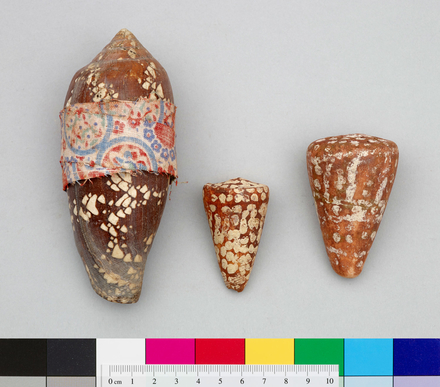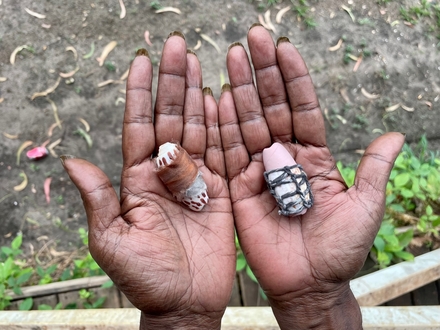In a first for the Art Centre, a collective of ten talented female artists from Anindilyakwa Arts on Groote Eylandt in the Northern Territory, were finalists in the 2023 Telstra NATSIAA.
The work, Dadikwakwa-kwa (Doll Shells) 2023, comprises 196 unique shell dolls arranged in a captivating 14x14 grid representing the fourteen clan groups of the Groote Archipelago.
The creation of Dadikwakwa-kwa was sparked by an ongoing collaboration between the Australian Institute of Aboriginal and Torres Strait Islander Studies (AIATSIS), Manchester Museum (UK) and the Anindilyakwa Land Council. Since 2019, the AIATSIS Return of Cultural Heritage Team, in partnership with Manchester Museum, have worked with the Anindilyakwa community regarding the potential repatriation of a collection of material held at Manchester Museum. The items were acquired from Umbakumba, Groote Eylandt in the 1950s.
Negotiation on the return of the collection is ongoing but AIATSIS led consultations in 2022, which focused on the cherished shell dolls, painted by parents for their daughters, which inspired the women of Anindilyakwa Art’s NATSIAA entry. In the past these culturally significant dolls, currently part of the Manchester Museum collection, were adorned with intricate ochre designs and often feature cloth from local settlements and mission stores.
During the consultations, the esteemed Senior women of Umbakumba, notably Edith Mamarika, Jennie Barabara, and Millie Mamarika, passionately shared cherished memories of the shell dolls. The Senior women vividly described how they played with the dolls as children and learnt kin relationships by reenacting family roles with them in the sand. Edith Mamarika explained: I remember playing with these, my grandmother use to come with us to collect them [shells], we use to collect lots. I played with these shells when I was a girl, six or seven years old…and my grandmother taught me how to play with it [doll shells]. The insights gleaned from these discussions, accompanied by compelling images captured by the collector Professor Peter Worsley in 1952, further enriched our understanding of these culturally significant artifacts (Figure 1, 2, 3, and 4).
The consultation process involved the active participation of the talented artists from Anindilyakwa Arts. Shell dolls have not been created on the Eylandt for over five decades. After hearing the stories from their Elders, the Women's Art Program at Umbakumba and Angurugu enthusiastically initiated a project to revive the practice of crafting shell dolls, which are now expressions of Anindilyakwa's contemporary artistic practice and culture.
Under the guidance of artworkers Noleen Lalara and Macie Lalara, the women are continuing to meticulously gather the same shells their ancestors collected and adorning them with locally sourced ochre pigments before the shells are carefully wrapped in bush-dyed silk cloth, malbalba (bush string), stringy bark, mangkurrkwa (pandanus), native leaves, or any other material that calls to the artist. Since the completion of Dadikwakwa-kwa, the women of Anindilyakwa Arts have spearheaded a youth engagement program where the shell doll stories, and creation is taught to younger generations.
Marcie Lalara, one of the leading artists involved in the project, expressed her motivation, stating, "Seeing the photos and hearing the old ladies talk about the dolls inspired the shell project and we put them in the Telstra Aboriginal Art Awards. Making dolls like this it's just from here. We follow the old ways, weaving like the ladies and using string to make clothes for the dolls. The old ones should come back too so we can see them and their designs. We don't want to lose our culture, and we want to share our knowledge with the world."
The Dadikwakwa-kwa artwork serves as a testament to the rich cultural heritage of the Anindilyakwa Arts Centre and their outreach program. These visionary artists are now forging international connections, with plans to collaborate with doll makers in Namibia and seek a partnership in Austria to create dolls for future international exhibitions.
As AIATSIS and Manchester Museum continue their commitment to honouring and preserving Indigenous cultural heritage, collaborating with the Anindilyakwa community is a remarkable milestone in celebrating and revitalising the cherished tradition of shell doll artistry.
Dadikwakwa-kwa (Doll Shells) 2023
Artists:
- Noeleen Danjibana Lalara (Umbakumba)
- Maicie Lalara (Umbakumba)
- Sheanah Marawili (Four Mile Outstation)
- Charlene Wanambi (Four Mile Outstation)
- Elsie Bara (Four Mile Outstation)
- Annabell Amagula (Angurugu)
- Elouise Lalara (Angurugu)
- Jeanelle Mamarika (Umbakumba)
- Meaghan Wanambi (Four Mile Outstation)
- Marcia Mamarika (Thompsons Bay Outstation)
For media inquiries, please contact:
Media enquiries:
or SMS to 0476 843 522
About AIATSIS:
AIATSIS is Australia's only national institution focused exclusively on the diverse history, cultures and heritage of Aboriginal and Torres Strait Islander Australia. AIATSIS’ work includes facilitating collaboration and knowledge exchange between Indigenous communities, researchers, and cultural institutions.
About Anindilyakwa Arts, Groote Eylandt:
Anindilyakwa Arts is a thriving hub of creativity spanning the Groote Archipelago in the Gulf of Carpentaria Northern Territory. The Warnamamalya led creative program proudly supports local employment and encourages traditional and contemporary creative practices. Anindilyakwa Artists explore creative avenues through “old and new ways”, drawing on deep knowledge of traditional practice, and experimenting with concepts in contemporary art disciplines.
About Manchester Museum:
Manchester Museum, part of The University of Manchester, is one of the largest university museums in the United Kingdom. The museum houses extensive collections representing various cultures and civilisations, serving as a vital hub for education, research, and public engagement.



